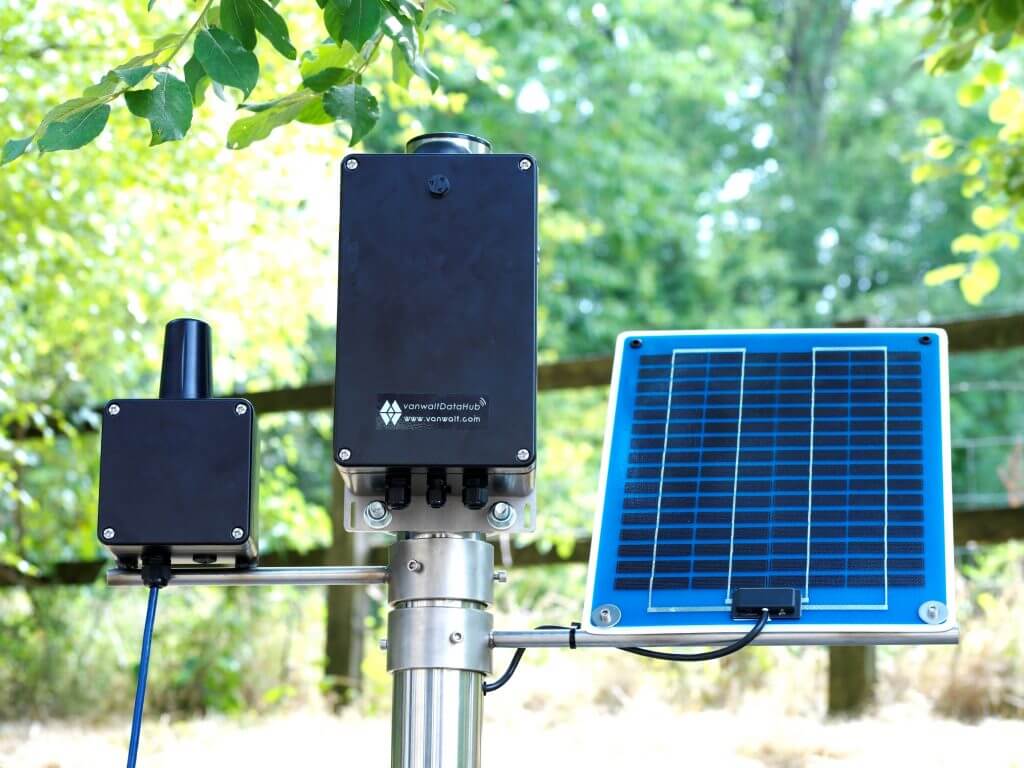
The Van Walt DataHub is a rugged, solar-powered environmental monitoring system that collects, stores, and transmits real-time data from multiple sensors in remote or challenging locations.
Developed in collaboration with Van Walt, the Van Walt Data Hub began as a reliable data logging system and has since evolved into a comprehensive environmental monitoring solution. With support from GB Electronics (GBE), the system now delivers enhanced functionality to meet a wide range of environmental monitoring needs, including flood risk assessment, rainwater reservoir gauging, and more.
At its core, the Data Hub collects and stores information from various environmental sensors. It can operate as a standalone data logger or be configured to transmit data via satellite, radio, or SMS, offering flexible deployment in remote or critical locations.
GBE played a key role in integrating advanced technologies into the platform, including the VanwaltCONNECT service for seamless remote access and data management. To further increase resilience and user flexibility, the system also incorporates SD card storage and satellite communication, ensuring continuous data access even when traditional connectivity is unavailable.
The result is a robust, future-ready monitoring system designed to empower environmental professionals with reliable, real-time data - anytime, anywhere.
Van Walt approached GBE with a clear but ambitious vision: to evolve their existing DataHub into a powerful, user-friendly environmental monitoring solution. At the heart of the brief was the need for a reliable, automated data storage system that could collect, organise, and safely store information from a wide range of environmental sensors.
Beyond just data logging, Van Walt wanted the system to offer flexible, easy access to data at any time, from anywhere. That meant not only local storage on robust dual SD cards, but also the ability to transmit data remotely via VanwaltCONNECT—an online platform designed for real-time access, alarms, and sensor control. The system also needed to be compatible with Windows software (Windows 7 and above), to ensure a smooth experience for end users in both the field and the office.
The DataHub also had to be tough. With deployments often in remote and harsh environments, the unit required a rugged, weatherproof design and support for multiple sensor types and communication protocols. Van Walt’s brief asked GBE to integrate all of this into one seamless, easy to use package so their customers could focus on monitoring the environment, not managing the technology.
During the production of the Van Walt Data Hub, the GBE team encountered challenges related to reduced battery charging power during the summer and winter months. After deployment, it became clear that areas with dense tree cover or limited winter sunlight could not supply sufficient solar energy to charge the 12V battery effectively. Our design team identified that improving battery efficiency would extend usage time and reduce charging needs. The solution we found was reducing the frequency of data collection cycles, which proved effective in conserving battery power and extending overall charge lifecycle.
We tested the panels on the roof of our office, connecting them to identical DataHubs, with one using two 20-watt panels, and one with only one panel. These tests were conducted on a range of days with differing temperatures and cloud coverage. The single and dual panels were both expected to perform well during periods of high lux, so this test is primarily concerned with the peak, average and continuous output levels of the panels during periods of low lux. The dual panel setup showed to reach optimal charge quicker, more regularly and remain at that level for longer than the single panel. This enabled us to conclude that, though not possible in all situations, the use of two 20-watt panels during the winter months and in low light areas should be considered. Our testing showed that in real-world-use situations, the dual panels will result in an increase in continuous up-time of the Datahub and thereby reduce data loss if the unit shuts down. Visits to site to change batteries would also be reduced or eliminated.
Our approach to the technological challenge was streamlined by our in-house compliance testing, allowing us to carry out tests on each stage of the data logger to confirm it was up to both our and Van Walt’s high standards. This involved passing numerous compliancy standards. Being able to test in-house is a major advantage for GBE as it ensures that the process is as smooth and efficient as possible, making it both more time and cost-efficient as it does not have to be constantly sent to other locations for testing.
GBE played a pivotal role in bringing the Van Walt DataHub to life, contributing to every stage of the product’s development, from concept to market readiness. Working closely with Van Walt, the team helped transform initial ideas into a fully functional, field-ready device. GBE integrated key design elements provided by Van Walt, including the VanwaltCONNECT platform, SMS messaging capabilities, and the system’s self-charging solar functionality, ensuring the final product met both technical and user requirements.
The end result was an extremely efficient data logger that can be utilised in a multitude of different areas to monitor and track a wide range of environmental data. The data logger is also compatible with an extensive series of sensors that may already be in place or installed alongside, including SD12, Analog, Pulse, Relay, and GPIO sensors.
Additionally, for customers that do not want to use the VanwaltCONNECT software the DataHub can be enabled to automatically forward data to a customer’s FTP Server. Data can be transferred in .csv, .dat, .XML, or JSON formats and bypasses Van Walt’s systems entirely. This ensures that the data can only be accessed by the customer, ensuring security and privacy.
Key Points